Antarctic
Diving down south
There are a few things different about diving here at Rothera than the diving that people do normally. One has to do with the deep low pressure systems that spin around the bottom of the globe. At the moment we have quite a few lows coming through base. As I type it is almost midnight and the wind has built all day from 17 knots this morning up to 42 knots at the moment. The waves are sculpting the icebergs into something a sculpture would be proud of! Anyways back to diving!
The magic figure is 977mb – meaning that when the pressure gets to less than 977 we have a correction to add in to the tables in the same way that you would if you were altitude diving.
The other thing that is different is orcas and leopard seals. I have mentioned before about seal watch well if you see either orcas or leps you can’t dive for 4.5hours at least. Talking about Orcas the resident pod came back last week into Ryder Bay. There were about 10 of them including a large male. There was an all stations call on the VHF that they were down at the wharf. Being at the boatshed we are right there which made for excellent viewing.
We also wear full face masks with a seperate bail out bottle and have integrated comms to talk to people at the surface. They take a little getting use to but I can see that I am now spoilt and will not like going back to the half mask and reg set up that is normal!
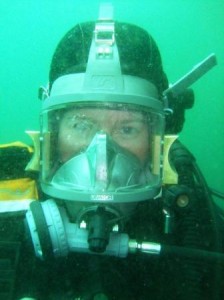
When we dive one person does the science while the other is a support diver holding onto a broom stick handle in case we meet and inquisitive sea creature.
We also don’t fly for 48 hours after diving and we only dive for 3 days before we have an enforced day off.
Wednesday I had my 5th dive down south in hanger cove which is very different to south cove and cheshire where I have been diving – a result of iceberg scour.
I am being trained to be a dive supervisor as well so will start taking on that role soon so that my days can be even more varied!!!
gutted
So I put my hand between the engine and the boat when I was tilting it the other day and now have a hand with two little punctures and up in a sling. So life is a little bit more challenging. Only one stitch but it was painful as the numbing stuff didnt work so needless to say i went through the roof when the needle went in!
No trip to the field for me over christmas and restricted use for a least 7 days. Luckily it didn’t go through the tendon but I am antibiotics as it is near the tendon sheath. However, this morning I have tested my left hand and can still drive the crane and tractor and am doing seal watch and working on the computer.
Can’t finish my christmas presents in the wood shed unfortunately… so presents will be late for those down here. 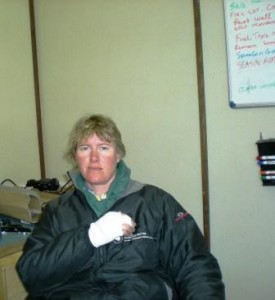
Oh well!!
Happy holidays everyone
Weather down here
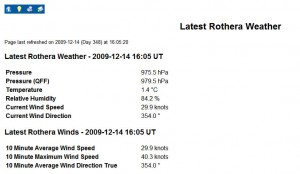
One of the harder things to get across to the scientists is that weather is a large factor in planning. Above is the information permanently on our computer screen. When there is a crosswind it flashes red so we are ready to scrabble for SAR requirements.
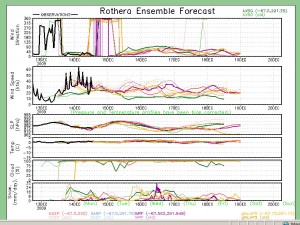
We use a program called Ensemble as well as having a full time Met Office Forecaster on station. It has 5 different models which tell you what to expect for the next 5 days.
Every morning at 7:45am the boatman is at the ops meeting to get the METARs and TAFs (Terminal Aerodrom Forecast) and also understand the Air SAR requirements for the day. The METARs look something like this…
EGAR 231000Z 06007KT 1000 -SN OVC015 MO1 MO2 Q974=
Translated that means
EGAR = station
23 = Date of issue
1000Z = Time in Zulu
060 = bearing in T
07KT = wind speed
1000 = horizontal distance visibility in meters
-SN = slight snow
OVC = type of cloud
015 = cloud height of 1500 feet
M01 = current temperature in C
M02 = dew point C
Q974 = sea level pressure MB
The TAFs look like this
EGAR24100Z 2412/2424 06013KT 5000 HZ BKN016 TEMPO 2412/2416 1200 SNBKN012 TEMPO 2412/24150300 SN BR BKN005 BECMG 2414/2417 09022G32KT 999 SCT025 BKN025=
So from that I get the forcast that was issued at 1000Z for rothera on 24th that covers 1200Z to 2400Z on the 24th of 060 degrees wind at 13 knots with a temporary change between 1200 and 1600 becoming 090 at 22 knots with gusts 32 knots.
We also have another lot of information on the screen this is plots showing us the historic trends in wind direction, speed, temperature etc.
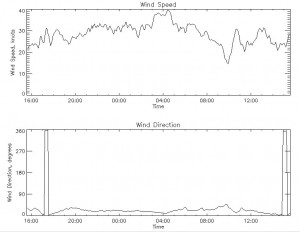
On top of all this we have HORACE which is the met offices program with animated weather charts.
Merry Christmas… maybe not..
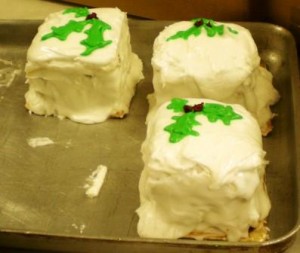 Claires cakes for the field parties
Claires cakes for the field parties
After waking up at 8am to see if I might be able to take some scientists out to the islands I retreated back to bed as it was my day off and it was blowing horizontal snow. I rowed 10km on the rowing machine in the gym and then after a leisurely brunch headed out for some ice climbing with a group. After ice climbing in shitty conditions – gusting 40 knots we wondered back to the bar and decorated it for christmas.
So it seems like everyone who has spent time down here is a scrooge and isn’t into christmas at all which kind of sucks. Us newbies have our advent calenders and Claire spent an afternoon making christmas cake last week.
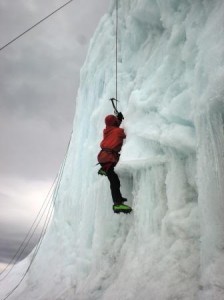
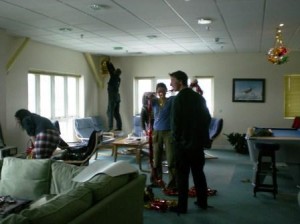
However, I still haven’t got the christmas spirit going especially as we will be working on the actual day! But I might be lucky as I might be sent out to the field for a week over christmas in which case I will be in a little hut 200 miles from here on the actual day with the parcel my mother sent down.
For Paige and Rebecca!
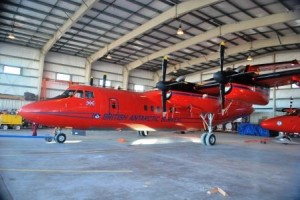
The Dash 7 in the hanger
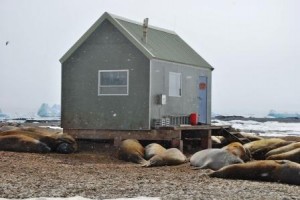
Outside of the hut at Lagoon
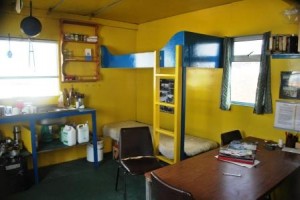
Inside of Lagoon Hut
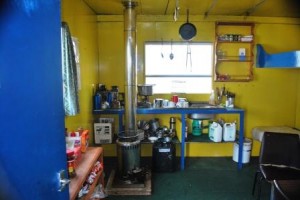
Another picture of inside of Lagoon Hut showing the reflex stove.
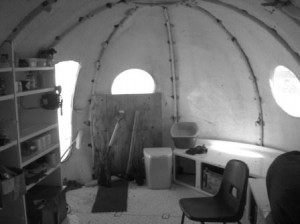
Inside Anchorage hut – needs some girls to come and sort it out!
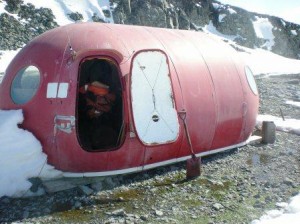
Outside of hut at anchorage
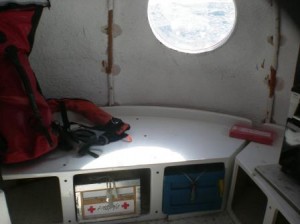
One of the small uncomfortable looking bunks in Anchorage hut
Tagging Out
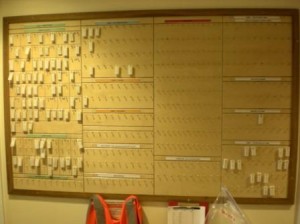
There are up to 105 people on base at its height this season and so there is a need for a system of keeping tabs on where everyone is. The support staff are pretty constant however, people are coming and going into the field everyday and also visiting scientists are in an out of base for sometimes only a few days.
The picture above is of the tagging out board. The station is divided into zones and then there is local travel, boating, islands, field, flying etc. When you are moving from one zone to another you have to move your name tag to the correct zone. If you are going off station you have to write in a book your name and where you are going. All the support staff carry a VHF radio 24 hours a day as well and we have a repeater on reptile ridge which give channel 18 a much broader effective area. My radio is on at night as well as Claire’s my roommate as I am on SAR duty most of the time and Claire is the Dr.
Who ever is on gash is in charge of checking every half hour the book and sometimes a call will go out on VHF looking for someone who is over due or forgot to tag themselves back into the station. So a very effective way of keeping people safe.
7 dresses! (outfits)
So living down here is pretty crazy in the amount of time you change clothing each day. In one day I am regularly in 7 different outfits.
I start my day at 6:45am in my gym clothing and go and row 5km on the rowing machine. Back by 7:30am in my room and change into office clothing.
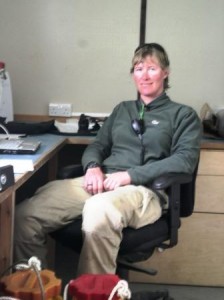
At 8:30am I am in the boatshed doing some maintenance. Despite the insulation they installed the shed gets down to -20 in the winter so we have insulated boiler suits we wear so as not to get grease etc over everything.
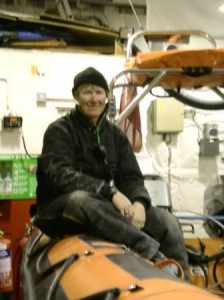
Through out the day I might be in and out of the boiler suit, my diving dry suit and my boatsuit as I take scientists out on the water.
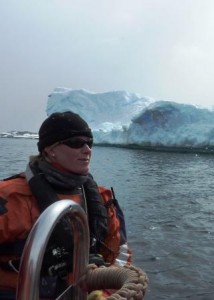
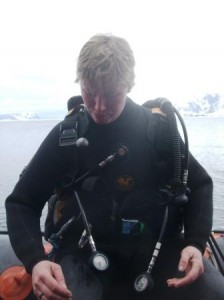
If there is not too much wind I am back in my gym cloths to run before dinner on the runway at 6pm. Then change into ordinary trousers and shirt for dinner. After dinner it is normally time to go mountaineering, ice climbing or skiing so back to the room to change into outside clothes.
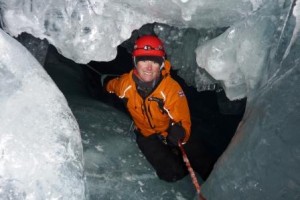
Food and Breaks
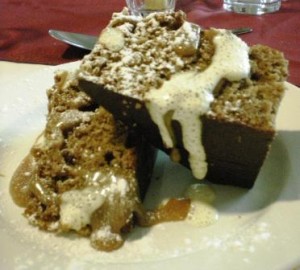
Dessert on a saturday night – sticky toffee pudding… yummy
We have a great view from the cafeteria out over hanger cove and the icebergs in a northerly get all packed in the bay. Normally you can eat dinner while watching seals and penguins go about their business. Last week a pod of Orcas wondered by.
Breakfast is self serve and is cereal, canned fruit, homemade bread for toast it starts at 06:30 and continues till 08:30.
At 10:30 there is a morning smoko which used to be bacon baps however, everyone was putting on so much weight on station we now just eat what ever is in the fridge by the toasters – cold cuts, cheese etc. I have only managed to make it to one smoko since I got here. Normally I am hard at work and don’t want to stop the momentum I have got going on.
Lunch is between 1300 and 1400 and is normally soup and homemade bread and then a pasta dish like lasagna, mac and cheese etc.
Afternoon smoko is at 16:00 and used to include cakes but doesn’t anymore.
Dinner is at 18:30 till 19:30 except on Saturday nights when there is tablecloths a three course meal served at the table and everyone has to dress up.
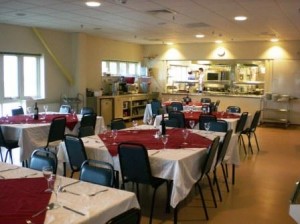
Food is pretty good but full of carbs and there is really no fresh fruit or veg. Everything comes to the station canned, frozen or dry so the chefs have a tough job to created good food. As you can imagine if there is a bad chef the mood on base gets quite bad!
What a crazy morning!
This morning there were crosswinds from the first flight. Lucky for us there is only one twin otter on base at the moment and the conditions were not good for the Dash 7 to fly. Between Danny and I we had to cover a trip to Leonie for sediment sampling, four SAR calls and a trip the girls wanted to take for some CTD testing all before lunch. It is crazy because we can only have one boat on the wharf at a time and we don’t really have enough crew to pull from. On top of this we needed to finish getting the boat packed up that is going to the falklands. This weekend Danny is on SAR so I have the weekend off and am going on a mini break. On Saturday morning he is going to train some more crew which will give us a little more choice.
The great thing about base life is that the mechs are 250 yards away so when we realised the boat on its trailer was not going to fit in the container we took the boat off and took the trailer for modifications up to the mechs. A day and half later we had a collapsable trailer! All they charge me is hugs! I know it is true the rough tough tech services guys will do anything for me if I give them a hug!
The afternoon was spent putting the remainder of the new stuff that came in on relief into inventory and I turfed all the stuff out of the boats and dried it all out. The safety gear is now in dry bags and hopefully it will stay that way. Next week I will be powerwashing the boats and then will start detailing each one and make this into a permanent thing on the calender.
The boatshed is now organised a little bit better and all the extraneous stuff has been removed – it seemed like it had become a little bit of a dumping ground for people on base! There were things from the air unit, field assistants etc. So basically Danny and I have been spring cleaning.
CTD stands for Conductivity, temperature and Depth this probe is put down to 500m two times a week at Rothera giving scientist lots of information for oceanagraphic study. See a report by the marine assistant in 05
Newspapers
Every morning we have a condensed version of a newspaper at the breakfast table. It is about 6 pages long and includes world, financial, sports news and the weather for all the major cities in the world. There is a crossword puzzle that is normally done by people with time for their morning smoko at 10:30am or those on standby to fly out to the field.

